Marketing Presentation: Launching a Luxury Car Rental Service
VerifiedAdded on 2023/06/12
|9
|1210
|429
Presentation
AI Summary
This presentation provides a comprehensive marketing pitch for a new luxury car rental service. It details the service offering, which includes renting luxury cars purchased by the business and cars registered by individual owners, with options for drivers and GPS tracking. The target market is identified as high-income tourists and adults, as well as families on vacation. The positioning strategy aims to portray the service as luxurious, customer-friendly, and high-quality, leveraging a competitive advantage through a unique fleet of premium vehicles. The distribution strategy focuses on an online marketplace via a mobile app, connecting car owners and renters. A premium and dynamic pricing strategy is proposed, with revenue sharing between the business and car owners. The promotion strategy includes social media marketing, television advertisements, billboards, and digital marketing, along with tie-ups with local travel agents to maximize brand reach and customer acquisition. The presentation includes academic references to support the marketing strategies outlined.

Car rental company
Luxury car rentals for long durations
Luxury car rentals for long durations
Paraphrase This Document
Need a fresh take? Get an instant paraphrase of this document with our AI Paraphraser
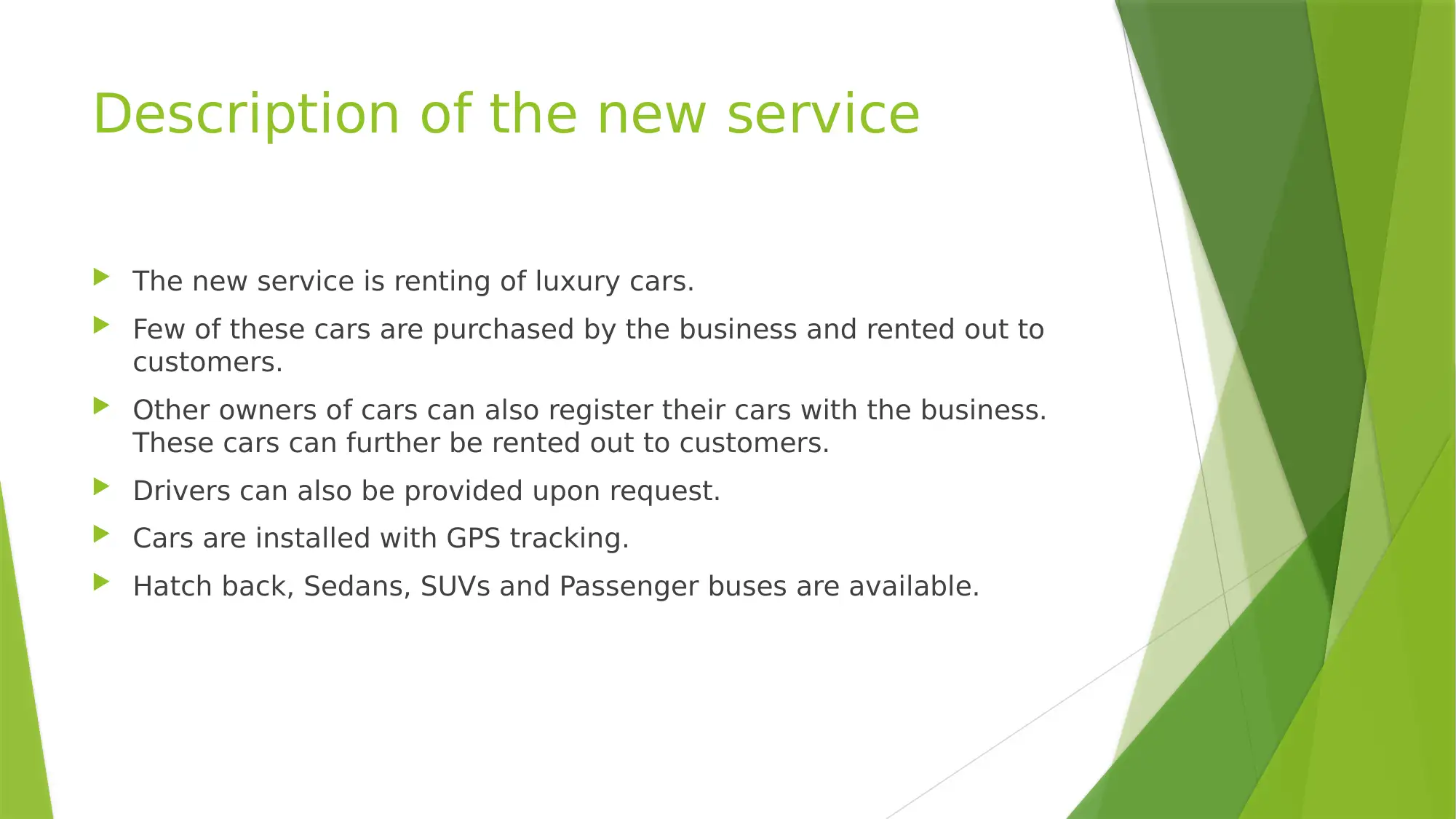
Description of the new service
The new service is renting of luxury cars.
Few of these cars are purchased by the business and rented out to
customers.
Other owners of cars can also register their cars with the business.
These cars can further be rented out to customers.
Drivers can also be provided upon request.
Cars are installed with GPS tracking.
Hatch back, Sedans, SUVs and Passenger buses are available.
The new service is renting of luxury cars.
Few of these cars are purchased by the business and rented out to
customers.
Other owners of cars can also register their cars with the business.
These cars can further be rented out to customers.
Drivers can also be provided upon request.
Cars are installed with GPS tracking.
Hatch back, Sedans, SUVs and Passenger buses are available.
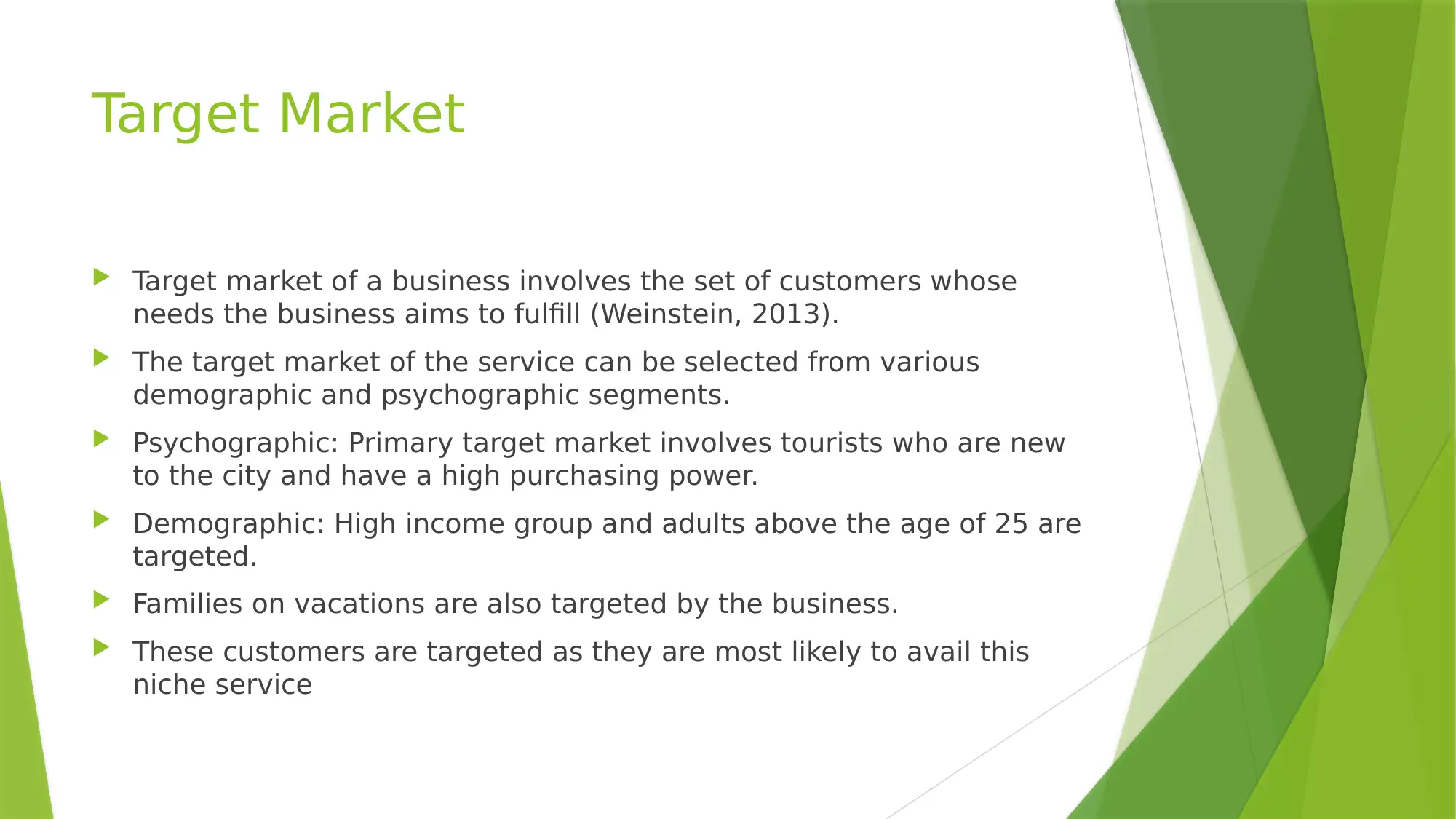
Target Market
Target market of a business involves the set of customers whose
needs the business aims to fulfill (Weinstein, 2013).
The target market of the service can be selected from various
demographic and psychographic segments.
Psychographic: Primary target market involves tourists who are new
to the city and have a high purchasing power.
Demographic: High income group and adults above the age of 25 are
targeted.
Families on vacations are also targeted by the business.
These customers are targeted as they are most likely to avail this
niche service
Target market of a business involves the set of customers whose
needs the business aims to fulfill (Weinstein, 2013).
The target market of the service can be selected from various
demographic and psychographic segments.
Psychographic: Primary target market involves tourists who are new
to the city and have a high purchasing power.
Demographic: High income group and adults above the age of 25 are
targeted.
Families on vacations are also targeted by the business.
These customers are targeted as they are most likely to avail this
niche service
⊘ This is a preview!⊘
Do you want full access?
Subscribe today to unlock all pages.

Trusted by 1+ million students worldwide
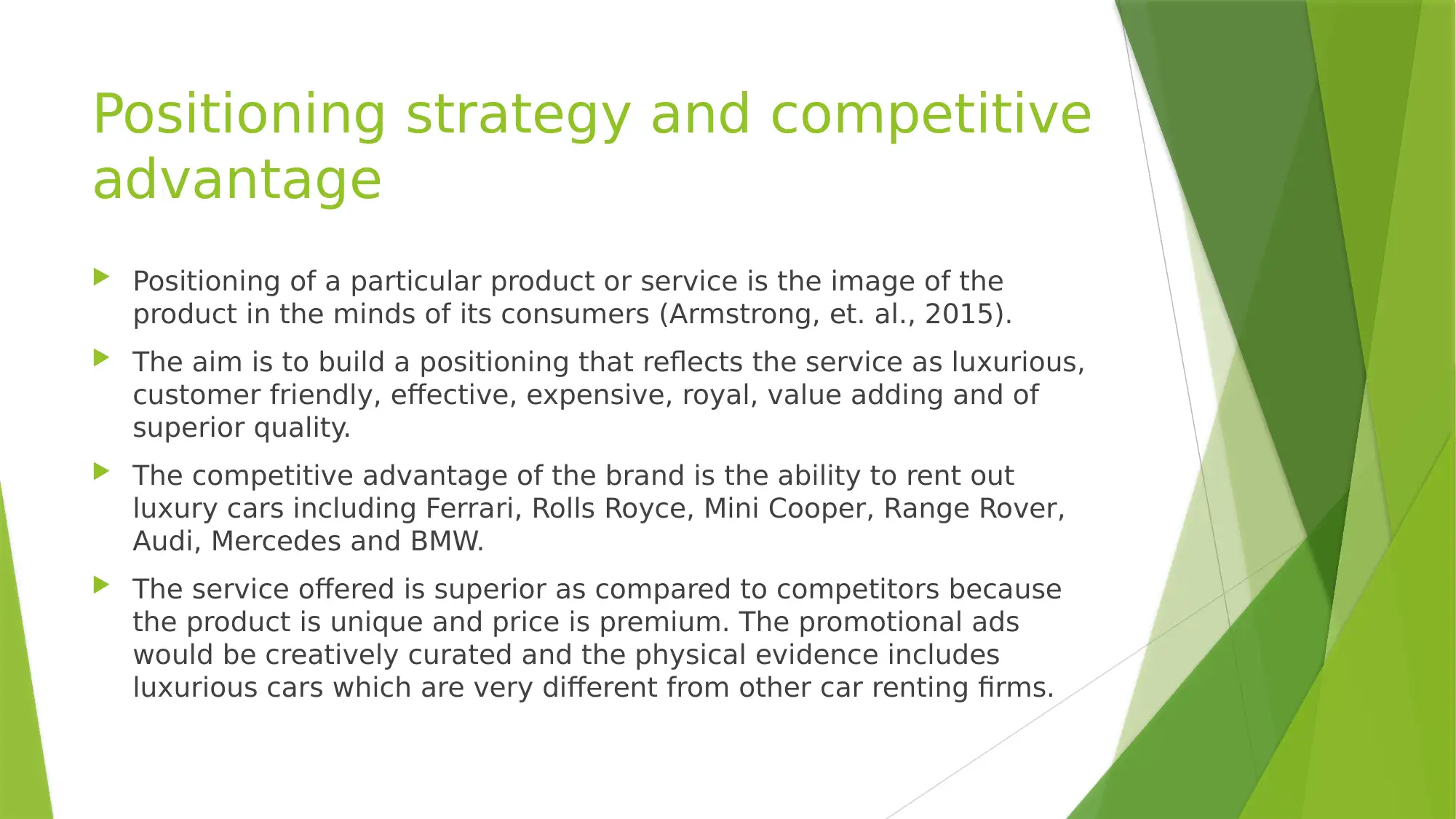
Positioning strategy and competitive
advantage
Positioning of a particular product or service is the image of the
product in the minds of its consumers (Armstrong, et. al., 2015).
The aim is to build a positioning that reflects the service as luxurious,
customer friendly, effective, expensive, royal, value adding and of
superior quality.
The competitive advantage of the brand is the ability to rent out
luxury cars including Ferrari, Rolls Royce, Mini Cooper, Range Rover,
Audi, Mercedes and BMW.
The service offered is superior as compared to competitors because
the product is unique and price is premium. The promotional ads
would be creatively curated and the physical evidence includes
luxurious cars which are very different from other car renting firms.
advantage
Positioning of a particular product or service is the image of the
product in the minds of its consumers (Armstrong, et. al., 2015).
The aim is to build a positioning that reflects the service as luxurious,
customer friendly, effective, expensive, royal, value adding and of
superior quality.
The competitive advantage of the brand is the ability to rent out
luxury cars including Ferrari, Rolls Royce, Mini Cooper, Range Rover,
Audi, Mercedes and BMW.
The service offered is superior as compared to competitors because
the product is unique and price is premium. The promotional ads
would be creatively curated and the physical evidence includes
luxurious cars which are very different from other car renting firms.
Paraphrase This Document
Need a fresh take? Get an instant paraphrase of this document with our AI Paraphraser
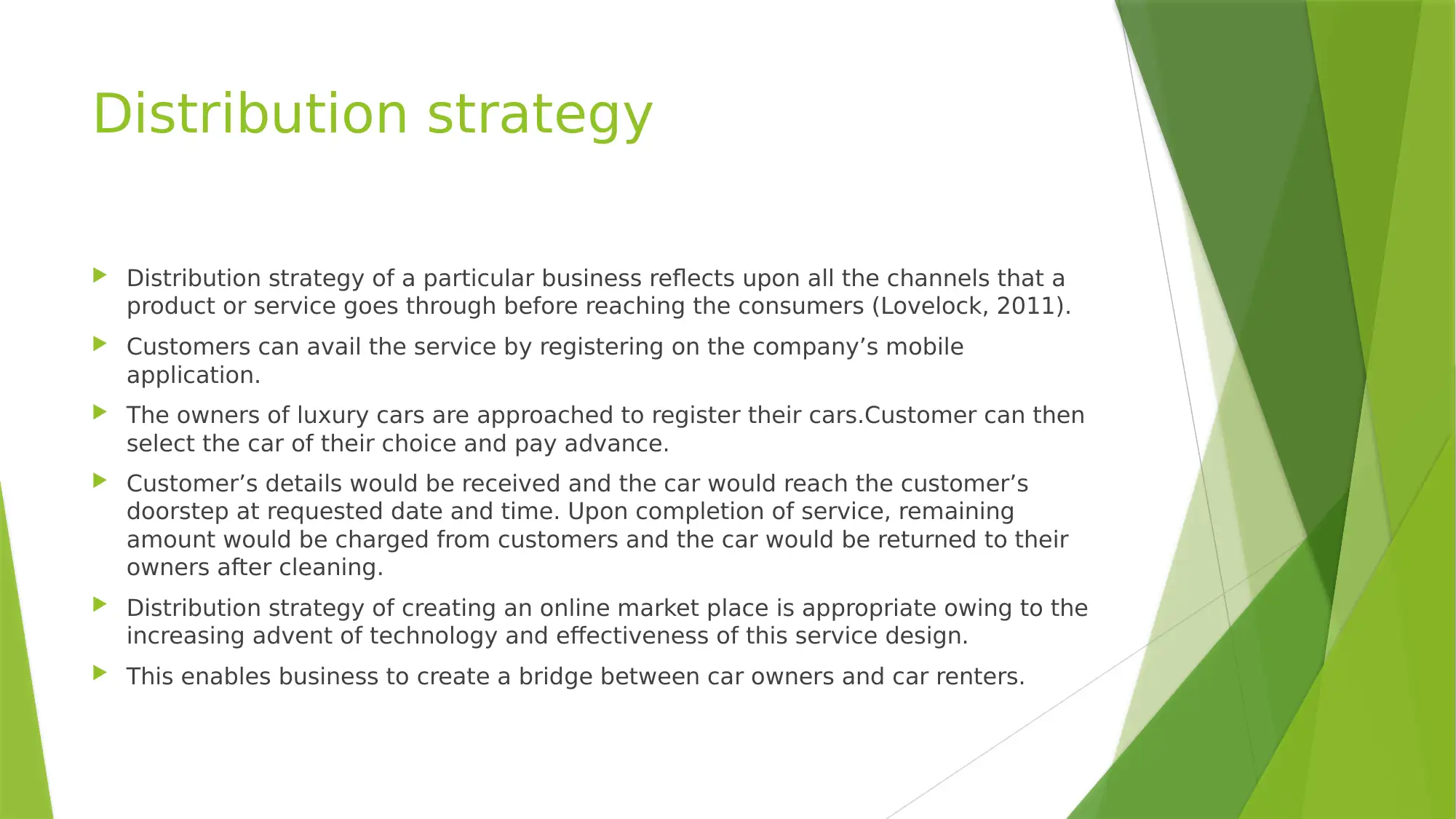
Distribution strategy
Distribution strategy of a particular business reflects upon all the channels that a
product or service goes through before reaching the consumers (Lovelock, 2011).
Customers can avail the service by registering on the company’s mobile
application.
The owners of luxury cars are approached to register their cars.Customer can then
select the car of their choice and pay advance.
Customer’s details would be received and the car would reach the customer’s
doorstep at requested date and time. Upon completion of service, remaining
amount would be charged from customers and the car would be returned to their
owners after cleaning.
Distribution strategy of creating an online market place is appropriate owing to the
increasing advent of technology and effectiveness of this service design.
This enables business to create a bridge between car owners and car renters.
Distribution strategy of a particular business reflects upon all the channels that a
product or service goes through before reaching the consumers (Lovelock, 2011).
Customers can avail the service by registering on the company’s mobile
application.
The owners of luxury cars are approached to register their cars.Customer can then
select the car of their choice and pay advance.
Customer’s details would be received and the car would reach the customer’s
doorstep at requested date and time. Upon completion of service, remaining
amount would be charged from customers and the car would be returned to their
owners after cleaning.
Distribution strategy of creating an online market place is appropriate owing to the
increasing advent of technology and effectiveness of this service design.
This enables business to create a bridge between car owners and car renters.
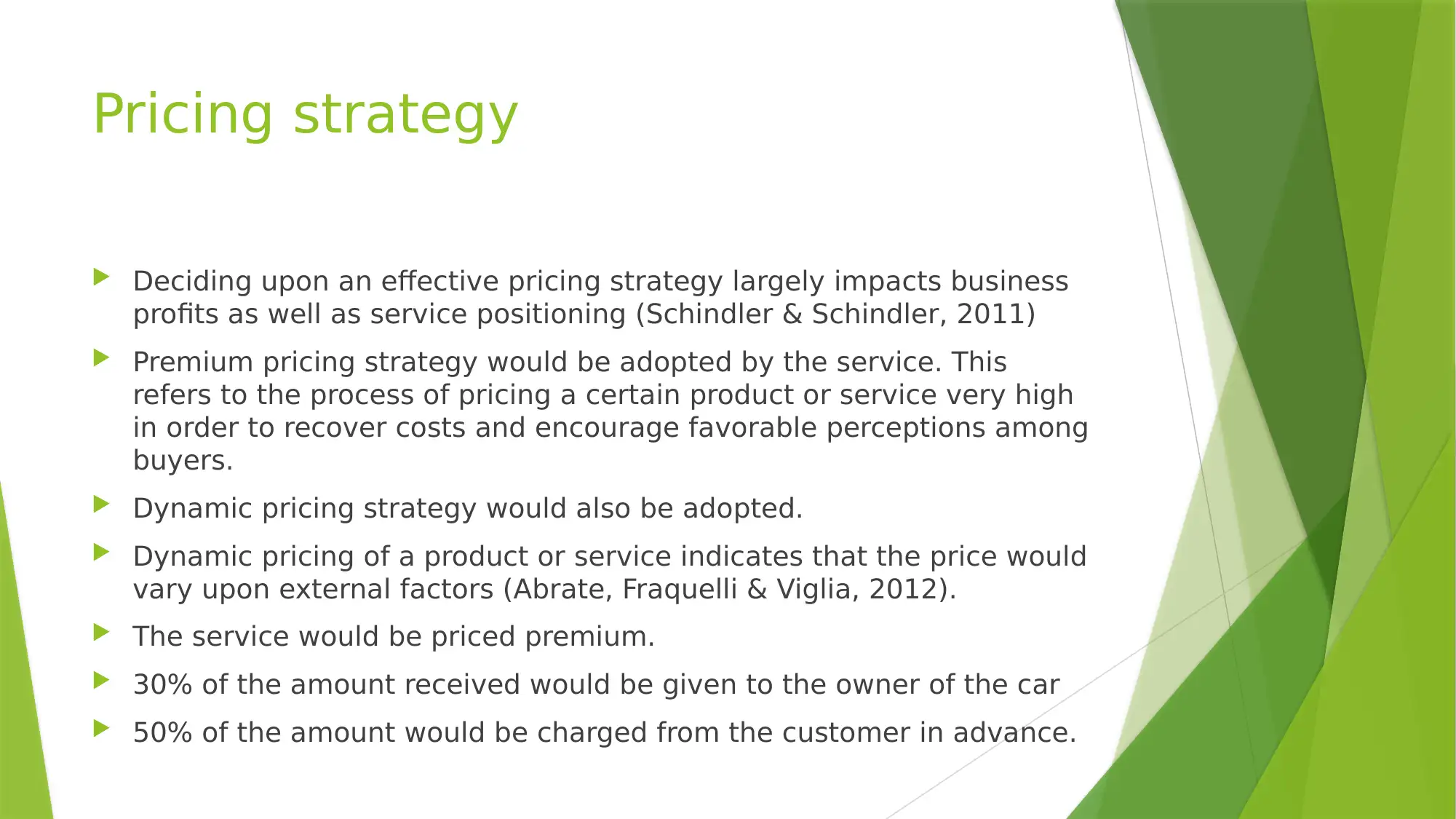
Pricing strategy
Deciding upon an effective pricing strategy largely impacts business
profits as well as service positioning (Schindler & Schindler, 2011)
Premium pricing strategy would be adopted by the service. This
refers to the process of pricing a certain product or service very high
in order to recover costs and encourage favorable perceptions among
buyers.
Dynamic pricing strategy would also be adopted.
Dynamic pricing of a product or service indicates that the price would
vary upon external factors (Abrate, Fraquelli & Viglia, 2012).
The service would be priced premium.
30% of the amount received would be given to the owner of the car
50% of the amount would be charged from the customer in advance.
Deciding upon an effective pricing strategy largely impacts business
profits as well as service positioning (Schindler & Schindler, 2011)
Premium pricing strategy would be adopted by the service. This
refers to the process of pricing a certain product or service very high
in order to recover costs and encourage favorable perceptions among
buyers.
Dynamic pricing strategy would also be adopted.
Dynamic pricing of a product or service indicates that the price would
vary upon external factors (Abrate, Fraquelli & Viglia, 2012).
The service would be priced premium.
30% of the amount received would be given to the owner of the car
50% of the amount would be charged from the customer in advance.
⊘ This is a preview!⊘
Do you want full access?
Subscribe today to unlock all pages.

Trusted by 1+ million students worldwide
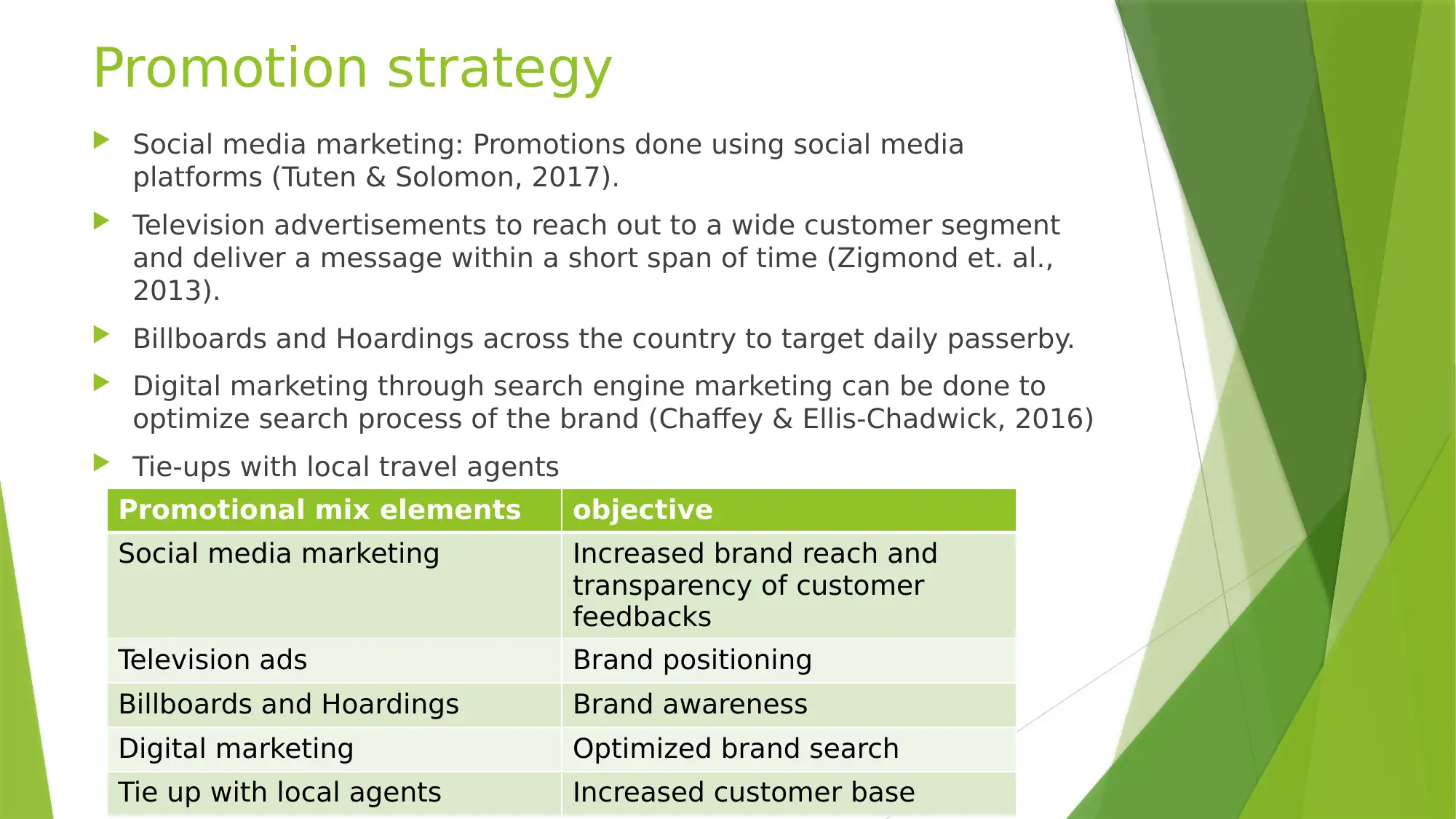
Promotion strategy
Social media marketing: Promotions done using social media
platforms (Tuten & Solomon, 2017).
Television advertisements to reach out to a wide customer segment
and deliver a message within a short span of time (Zigmond et. al.,
2013).
Billboards and Hoardings across the country to target daily passerby.
Digital marketing through search engine marketing can be done to
optimize search process of the brand (Chaffey & Ellis-Chadwick, 2016)
Tie-ups with local travel agents
Promotional mix elements objective
Social media marketing Increased brand reach and
transparency of customer
feedbacks
Television ads Brand positioning
Billboards and Hoardings Brand awareness
Digital marketing Optimized brand search
Tie up with local agents Increased customer base
Social media marketing: Promotions done using social media
platforms (Tuten & Solomon, 2017).
Television advertisements to reach out to a wide customer segment
and deliver a message within a short span of time (Zigmond et. al.,
2013).
Billboards and Hoardings across the country to target daily passerby.
Digital marketing through search engine marketing can be done to
optimize search process of the brand (Chaffey & Ellis-Chadwick, 2016)
Tie-ups with local travel agents
Promotional mix elements objective
Social media marketing Increased brand reach and
transparency of customer
feedbacks
Television ads Brand positioning
Billboards and Hoardings Brand awareness
Digital marketing Optimized brand search
Tie up with local agents Increased customer base
Paraphrase This Document
Need a fresh take? Get an instant paraphrase of this document with our AI Paraphraser
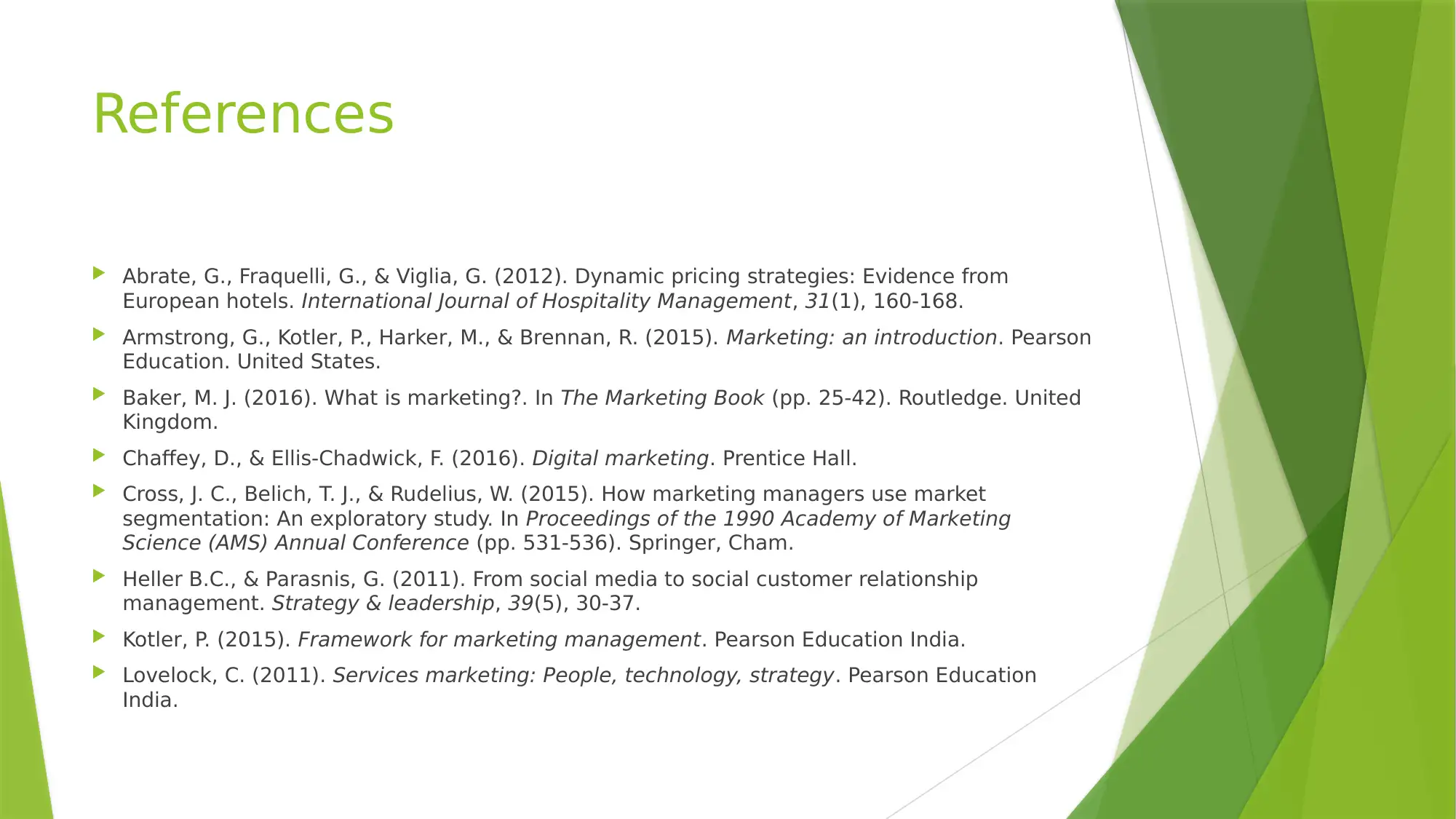
References
Abrate, G., Fraquelli, G., & Viglia, G. (2012). Dynamic pricing strategies: Evidence from
European hotels. International Journal of Hospitality Management, 31(1), 160-168.
Armstrong, G., Kotler, P., Harker, M., & Brennan, R. (2015). Marketing: an introduction. Pearson
Education. United States.
Baker, M. J. (2016). What is marketing?. In The Marketing Book (pp. 25-42). Routledge. United
Kingdom.
Chaffey, D., & Ellis-Chadwick, F. (2016). Digital marketing. Prentice Hall.
Cross, J. C., Belich, T. J., & Rudelius, W. (2015). How marketing managers use market
segmentation: An exploratory study. In Proceedings of the 1990 Academy of Marketing
Science (AMS) Annual Conference (pp. 531-536). Springer, Cham.
Heller B.C., & Parasnis, G. (2011). From social media to social customer relationship
management. Strategy & leadership, 39(5), 30-37.
Kotler, P. (2015). Framework for marketing management. Pearson Education India.
Lovelock, C. (2011). Services marketing: People, technology, strategy. Pearson Education
India.
Abrate, G., Fraquelli, G., & Viglia, G. (2012). Dynamic pricing strategies: Evidence from
European hotels. International Journal of Hospitality Management, 31(1), 160-168.
Armstrong, G., Kotler, P., Harker, M., & Brennan, R. (2015). Marketing: an introduction. Pearson
Education. United States.
Baker, M. J. (2016). What is marketing?. In The Marketing Book (pp. 25-42). Routledge. United
Kingdom.
Chaffey, D., & Ellis-Chadwick, F. (2016). Digital marketing. Prentice Hall.
Cross, J. C., Belich, T. J., & Rudelius, W. (2015). How marketing managers use market
segmentation: An exploratory study. In Proceedings of the 1990 Academy of Marketing
Science (AMS) Annual Conference (pp. 531-536). Springer, Cham.
Heller B.C., & Parasnis, G. (2011). From social media to social customer relationship
management. Strategy & leadership, 39(5), 30-37.
Kotler, P. (2015). Framework for marketing management. Pearson Education India.
Lovelock, C. (2011). Services marketing: People, technology, strategy. Pearson Education
India.
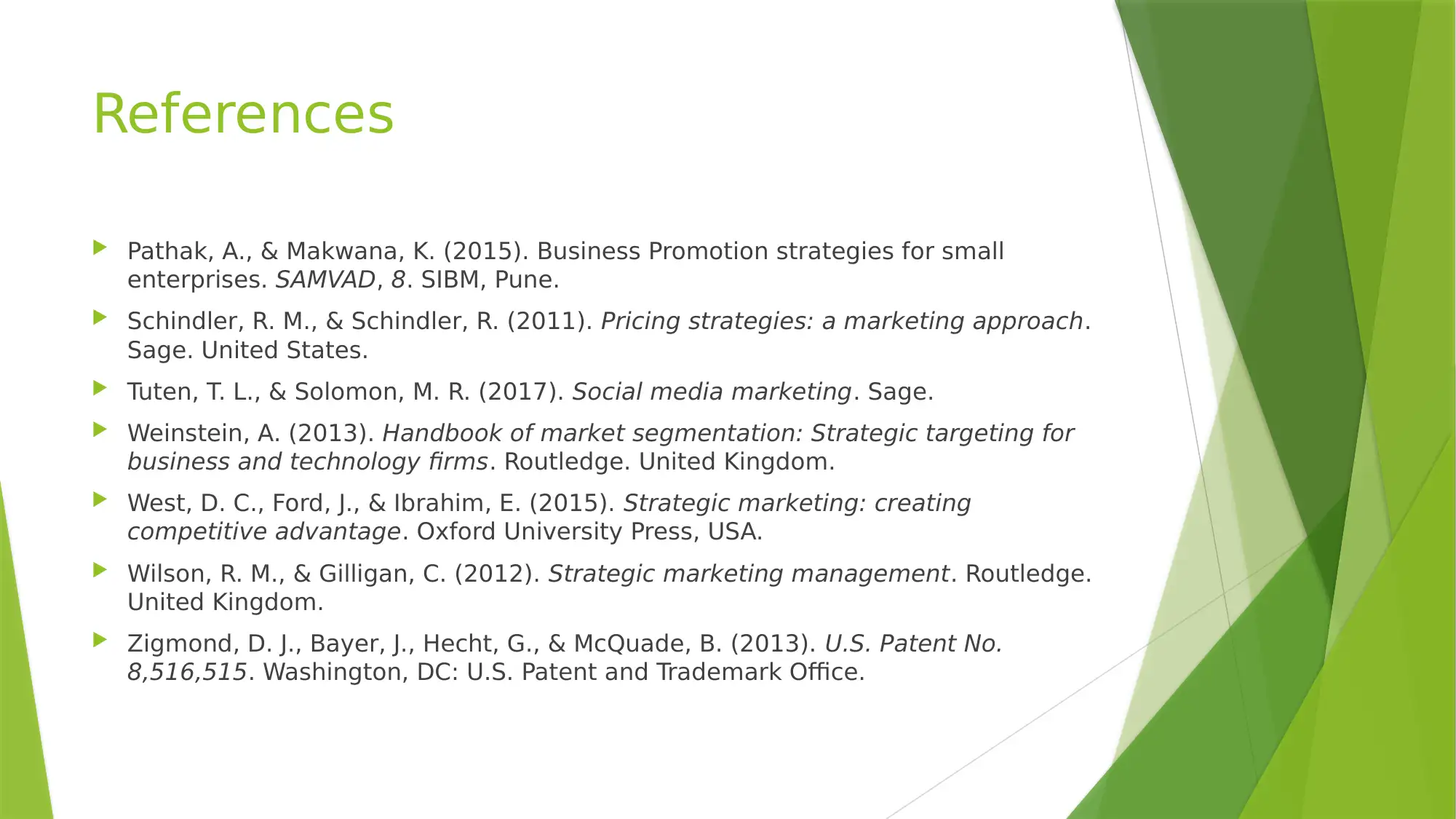
References
Pathak, A., & Makwana, K. (2015). Business Promotion strategies for small
enterprises. SAMVAD, 8. SIBM, Pune.
Schindler, R. M., & Schindler, R. (2011). Pricing strategies: a marketing approach.
Sage. United States.
Tuten, T. L., & Solomon, M. R. (2017). Social media marketing. Sage.
Weinstein, A. (2013). Handbook of market segmentation: Strategic targeting for
business and technology firms. Routledge. United Kingdom.
West, D. C., Ford, J., & Ibrahim, E. (2015). Strategic marketing: creating
competitive advantage. Oxford University Press, USA.
Wilson, R. M., & Gilligan, C. (2012). Strategic marketing management. Routledge.
United Kingdom.
Zigmond, D. J., Bayer, J., Hecht, G., & McQuade, B. (2013). U.S. Patent No.
8,516,515. Washington, DC: U.S. Patent and Trademark Office.
Pathak, A., & Makwana, K. (2015). Business Promotion strategies for small
enterprises. SAMVAD, 8. SIBM, Pune.
Schindler, R. M., & Schindler, R. (2011). Pricing strategies: a marketing approach.
Sage. United States.
Tuten, T. L., & Solomon, M. R. (2017). Social media marketing. Sage.
Weinstein, A. (2013). Handbook of market segmentation: Strategic targeting for
business and technology firms. Routledge. United Kingdom.
West, D. C., Ford, J., & Ibrahim, E. (2015). Strategic marketing: creating
competitive advantage. Oxford University Press, USA.
Wilson, R. M., & Gilligan, C. (2012). Strategic marketing management. Routledge.
United Kingdom.
Zigmond, D. J., Bayer, J., Hecht, G., & McQuade, B. (2013). U.S. Patent No.
8,516,515. Washington, DC: U.S. Patent and Trademark Office.
⊘ This is a preview!⊘
Do you want full access?
Subscribe today to unlock all pages.

Trusted by 1+ million students worldwide
1 out of 9
Related Documents
Your All-in-One AI-Powered Toolkit for Academic Success.
+13062052269
info@desklib.com
Available 24*7 on WhatsApp / Email
![[object Object]](/_next/static/media/star-bottom.7253800d.svg)
Unlock your academic potential
Copyright © 2020–2025 A2Z Services. All Rights Reserved. Developed and managed by ZUCOL.





